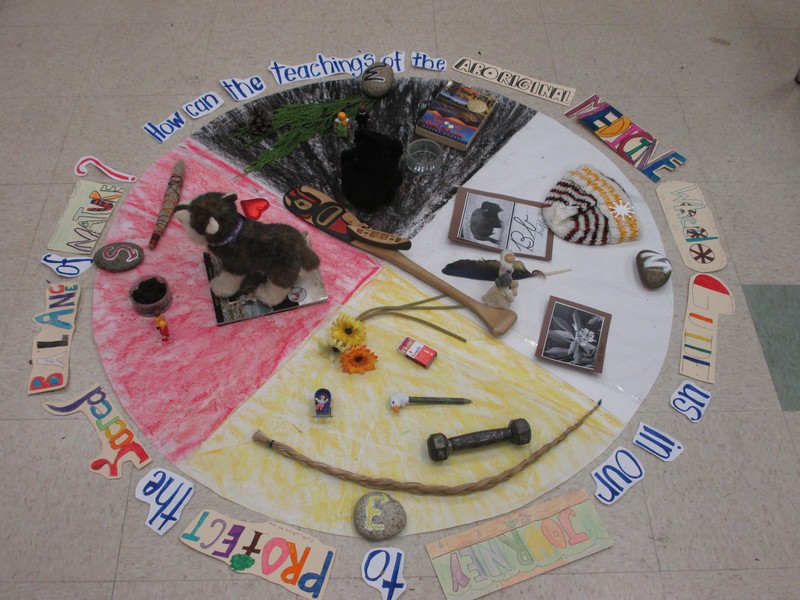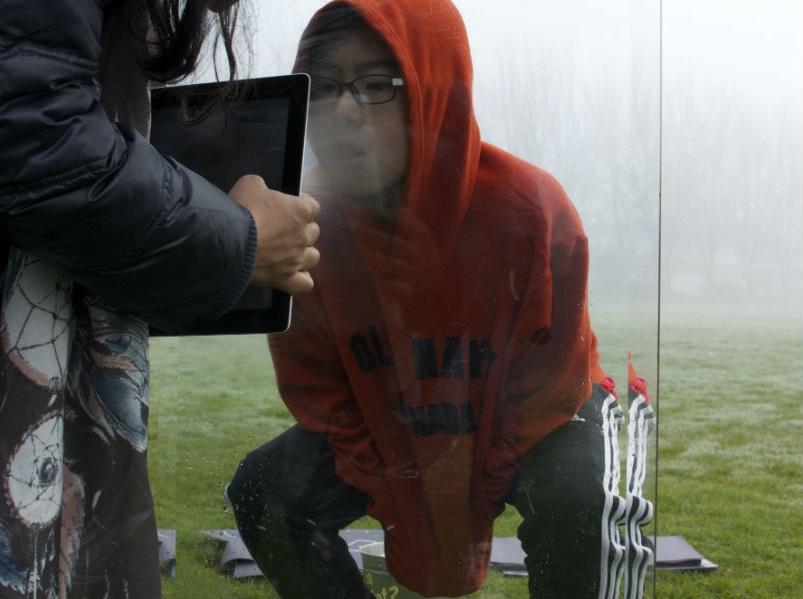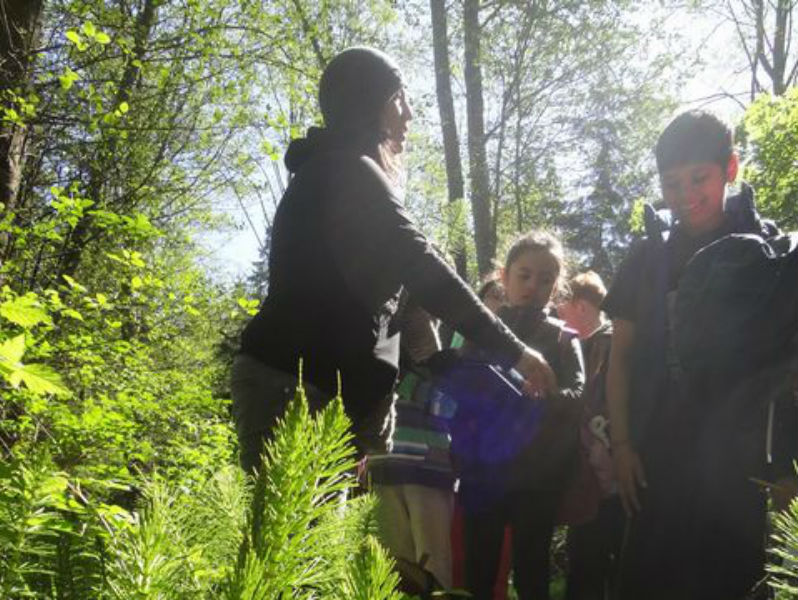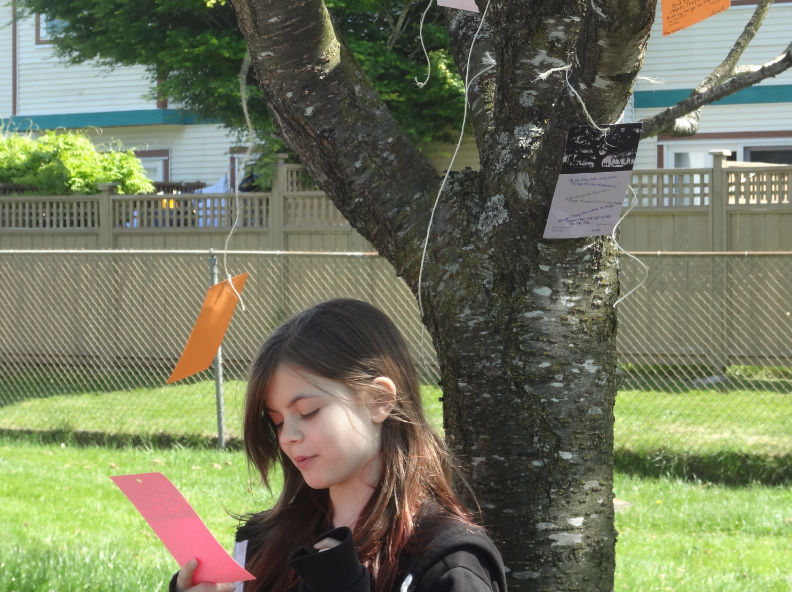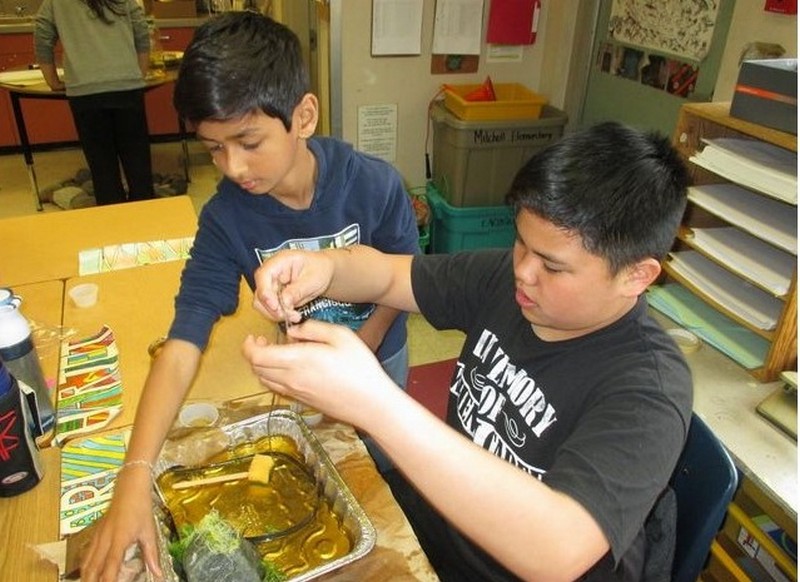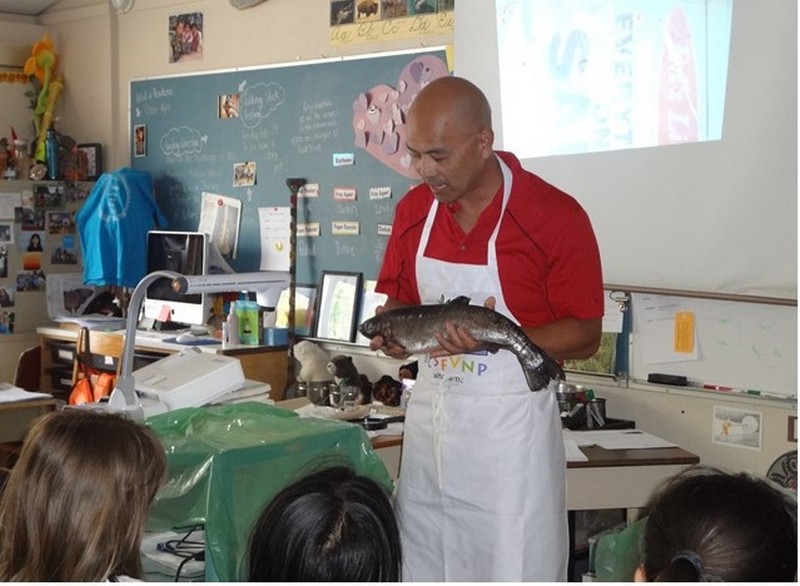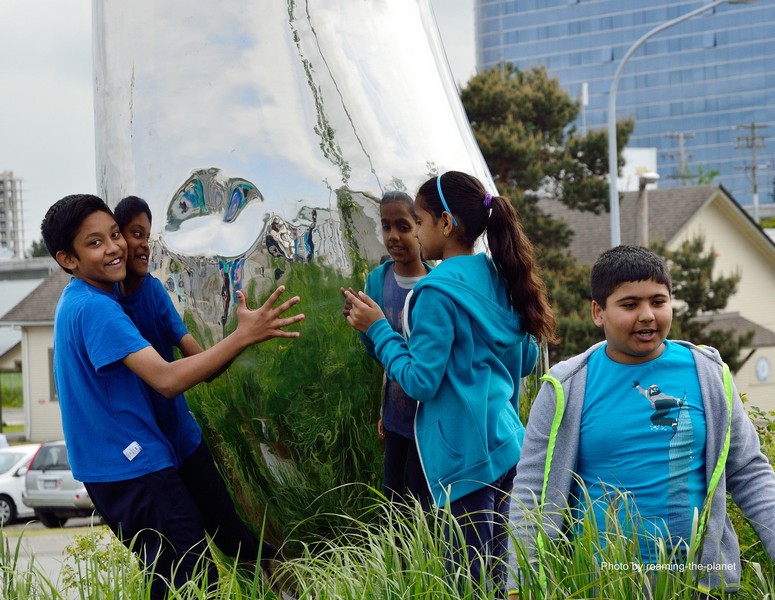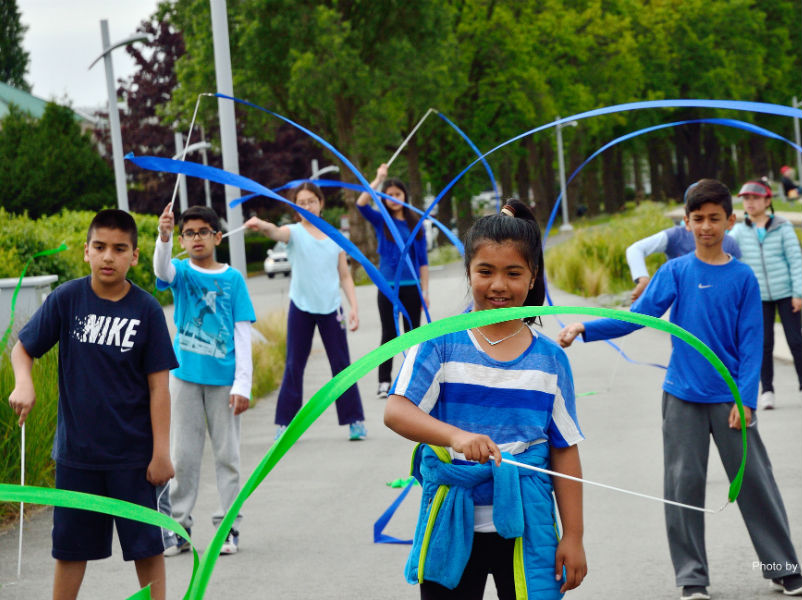Mitchell Elementary: Air, Fire, Water, Earth – Teachings from the Medicine Wheel
Arts Education, Language Arts, Mathematics
School: Mitchell Elementary, Richmond
Teacher: Anita Lau
Artist Collaborators: Cease Wyss
Class: Grade 5/6
Overview
This project-based learning explores the power of the Circle in First Nations tradition where the Circle represents the physical gathering place where people come to share ideas and listen. In the Circle the students learned to pass on the oral tradition of storytelling. Within the Circle of the Medicine Wheel can be found the 4 elements of Air, Water, Earth and Fire. As the students explore each of these elements, they expand their circle beyond the classroom to the natural world outside . From the Circle, they learned the importance of Balance and Harmony. The students learned the importance of our actions because in the essence of our Circle, there is the understanding everything are all connected.
Connection to the Vancouver Biennale Exhibition
The Vancouver Biennale artworks that inspired the exploration of the three elements – air, water, and fire are:
Air: Breath Song, Sumakshi Singh, India
This piece was explored with connection to the Mindfulness studies. The students incorporated poetry, mindful movement (yoga) and focused breathing to create their own Breath Songs. As Sumakshi says, “The intimate breath exhaled by one floats freely on air currents, to be received by another, oblivious of man made borders; a series of inhales and exhales shared all the way from New Delhi to Squamish.” This statement resonates with the exploration of how we are all connected.
Learning Resources:
http://www.vancouverbiennale.com/artworks/breath-song/
Water: Water #10, Ren Jun, China
The class visited this artwork with their exploration of the Fraser and the study of Salmon. In this element of water, the learning focus was on stewardship and sustainability. The students raised salmonids in their classroom and learned about the importance the Fraser River as it meanders in their own backyard. Jun Ren’s statement, “ The human race is part of nature and so are human thoughts. Only when we wholeheartedly use our wisdom to respect and dialogue with nature, can we truly establish ourselves with our discoveries” propels us to think about how we connect with nature and the meaning of respectful stewardship. The visit to the sculpture became an outdoor school experience of walking on the Richmond Dyke along the North Arm of the Fraser.
Resources:
http://www.vancouverbiennale.com/artworks/water-10/
http://www.vancouverbiennale.com/wp-content/uploads/2014/03/Ren-Water.pdf
Fire: 217.5 Arc x 13, Bernar Venet, France
This Biennale artwork was chosen to represent the element of Fire. Students studied the interaction of sculpture and its raw red-brown rust colour with the natural elements. Venet employs mathematical manipulations of this industrial material to explore the interconnected relationships between nature, humanity and the universe. The mathematics behind this piece also allows us to look for patterns in nature as we explore the element of fire.
Resources:
http://www.vancouverbiennale.com/wp-content/uploads/2014/03/Venet-Arc.pdf
http://www.vancouverbiennale.com/artworks/217-5-arc-x-13/
Other Sources of Inspiration
Rediscovery
Connecting The Dots, Stan Kozak and Susan Elliott
You are the Earth, David Suzuki
Keepers of the Earth, Michael Caduto and Joseph Bruchac
Keepers of the Night, Caduto and Bruchac
Music CD, Sweet Cascadia
Where My Wellies Take Me…, Clare and Michael Morpurgo
The Green Umbrella, Jill Brand
Weaving Through Words: Using the Arts to Teach Reading Comprehension Strategies, Mantione & Smead
Richmond Nature Park
Gulf of Georgia Cannery
BIG IDEA
Nature exists in a sacred balance as all elements of nature are connected and interdependent.
Guiding Question
How can the teachings of the Aboriginal Medicine Wheel guide us in our journey to protect the sacred balance of Nature?
Cross-Curricular Access
Language Arts: Poetry- Air, Water, Wind and Fire
Arts Education (Drama): Create and perform short skits and tableaus on the 4 elements from the ideas generated through the inquiry process
Arts Education (Music): Create Element Playlist and study the lyrics of songs with powerful messages on the environment and sustainability.
Arts Education (Visual Arts): Create a classroom mural with each group specializing on an element. Create an outdoor Medicine Wheel to show the four elements and the balance of the circle.
Mathematics: Explore the power of Stewardship through Seed Saving. Explore Patterns and Sequences in nature. Work with big numbers and estimation. Connect this with a Seed Campaign in the spring to fundraise monies for the garden.
Language Arts (Speaking and Listening): Experience the power of storytelling and learn the traits of a good storyteller.
Learning Process/ Inquiry Challenges
i. Opening: The Circle
Thhe project begun by introducing the Circle.
Entry Slip:What does the circle represent?
Exit Slip: How does the circle make us feel?
ii. The Four Elements
Entry Slip: What are the four elements?
Exit Slip: How am I connected to the elements?
Students were asked to bring in something that represents one of the elements.
iii. Connection-Class Web:
Chief Seattle’s speech inspires the students to think about connection. By weaving ribbons into a class web, the class creates a visual reminder that we are all connected and that each of us is responsible for the energy that we bring into our class.
iv. The Medicine Wheel
Learning about the significance of the Medicine Wheel in Indigenous teachings: The Medicine Wheel is an important symbol upon which our activities revolve around. Students made Medicine Wheel pouches to contain the 4 elements.
Over the course of the year, the class explore the Four Elements with a variety of activities.
Air: We are The Air
The Breath: Looked into the science behind our breath and our how our lungs work.
You’re Breathing Dinosaur Breath: Looked at what makes up air and how air joins together all of Earth’s creatures- past, present and future.
Inhale/Exhale: Explored air through Mindful Breathing. Took an in depth look at focused breathing and practice a variety of Breathing techniques.
Poet Tree: Haikus, Poems about AIR
Designated an official ‘Poet-tree’ in our schoolyard upon which to hang our poems and as a meeting place to read our poems outside.
Tree ID: We take an in depth look at how to classify trees and learn about the trees in our neighbourhood.
Artist: Emily Carr
Trees, the Lungs of the World: Learning about the ancient trees of the Great Bear Rainforest in British Columbia in our non-fiction study of Sea Wolves: Living Wild in the Great Bear Rainforest, by Ian McAllister & Nicholas Read
Storytelling: Gluscabi and the Wind Eagle, Eagle Boy
Songs: I’m a Tree (Sweet Cascadia)
Air is the World that we all of us Share (Leon Rosselson)
Art Installation: Class Communal Wind Chime
Art Installation: Pinwheels for Peace
Difference Makers: The Man Who Planted Trees, Wangari Maathai (Africa)
Action: Idle No More! To promote clean air on our school grounds. Students will lead a campaign to bring awareness to our parent community about the negative effects of idling their cars in the parking lot.
Creating the Breath Song: The students, with the support of the teacher and other resources from the school, recreated their interpretation of the Breath Song. The Breath Song by the students of Mitchell Elementary consisted of video recordings of the students breathing into a glass pane on a foggy morning and them writing words related to the element of air and breath on the construction paper. The teacher using technical help from the school, created a video superimposing each written word on the breath, thereby creating a truly collaborative interpretation of the Breath Song.
Water: We are the Water
Introduction:
Share Water Gallery images
Discuss themes about Water:
Universal experience.
Resource that we are lucky to have.
Many opportunities to be wasteful.
Water is thought of as sacred all over the world.
Guided Imagery: Begin with Mindful Moment. Play water sounds and lead students on a guided imagery visualization. Objective: mindful thinking and begin connection to water
Activity: Pass the Jug
Everyone has a cup on their desk. Start with you should drink 6-8 cups of water a day. Then teacher pour a cup of water for myself. (Don’t drink yet) Pass the jug. Next person shares and gets to fill their cup. At the end of the sharing of facts, the class have a TOAST to Water, Element of Life. Students can raise their glasses to their favourite fact. Hand out the Water Facts to students to glue into their books. Put a water drop around their favourite fact.
Water is _______ (simile/metaphor brainstorm). (We can do this on chart paper, and continue to add to this as you work with them on water, to save for poetry on the dyke)
Read a few water poems to Inspire. See Water is Life, Water is Poetry samples.
Poetry Response:
The poem made me feel…
Images I thought of…
Words I liked…
I like the idea of brainstorming simile and metaphors to take to the dyke for a poetic write.
Note: Students will also be composing a spoken word poem (We are Water) in their Element group.
Drama Activities:
The Vision Seeker: storytelling
Tableau: The First Salmon Ceremony
Element Groups will present short skits:
Air: Out of the Sky (Onondaga tribe)
Water: Ahaiyata and the Cloud Eater (Zuni)
Earth: The Myth of Gaia (Greek)
Fire: The Gift of Prometheus (Greek)
Engaging with Public Art: Water #10. Sit down in circle with clipboards. Do the AFTER column of Water #10. What do you SEE, THINK, FEEL and WONDER about Water #10 now that you are here? Have your thoughts and feelings changed?
Timeline: Revisit timeline spool. Unwind along the dyke. What was land around the Fraser so valuable to the Musqueam people? Why is land around this area so valuable to people today? Look and listen. Are the uses of the Fraser River different than they were thousands of years ago? 5 min Walk to Fishing Net (Water Sky Garden) by Oval.
Storytelling: The First Salmon Ceremony
Water Cycle: Complete water cycle diagram.
Power Words: Look at words on wall. Choose your power word about water. Write statement why you chose the word on the back of your sheet. In Element groups, compose a photo together with words.
The Fraser’s Journey: Look at journey of the Fraser River on map. Dear Diary, write diary entry of your journey to the Pacific. 10 minute walk to Terra Nova Park
Earth: We are the Earth
Storytelling: The Earth on Turtle’s Back, Tunka-shila, Grandfather Rock, The Myth of Gaia
Poet Tree: Haikus, Poems about EARTH
Soil Studies: We take a detailed look into soil composition and conduct soil tests in our schoolyard garden.
Vermicomposting: Students look after red wigglers in our Vermicomposting Bin and learn about the importance of compost and decomposers.
Dining on Dirt (David Suzuki): We look into where our food comes from and the importance of food systems and sustainability.
Indigenous Uses of Native Plants: We want to create awareness of Native Plants used by First Nations in our region. We would like to dedicate a plot in our garden to bring this knowledge to our students. We also want to create an Information Booklet to outine the uses and importance of these plants in Indigenous Knowledge.
Action: Flower Seed Kindness Balls; Growing Seedlings
Field trip: The students explored Cease’s work with the ‘nurse trees’ at Stanley Park. I love the message of how the cycle of life returns to the earth and how Cease uses what may seem to some as an ending of fallen trees after the big storm, to teach us how it really is a beginning and how the circle of life continues again. The totems at Stanley Park and Cease’s guidance through the forest there will undoubted be an enriching experience.
Fire: We are the Fire
Story: Lot-Wit, the Fire-Keeper
Plugging into the Sun (David Suzuki): A look into how we use the Sun’s energy and the importance of the cycle of energy in nature.
Action: We make a Sundial for the garden.
We Are Connected: Harmony and Balance
Song & Drama: The Green Umbrella- We will perform a short drama at the end of the year in the garden to showcase and share our knowledge of the Elements and the Teachings of the Medicine Wheel.
See previous section of how we plan to use the Biennale Exhibition for Discovery and Inspiration.
In each element, we bring in the wisdom outlined in the First Peoples Principles of Learning
http://www.fnesc.ca/curriculum
Student Creation
Students expressed their understanding of the Four Elements in written, spoken and artistic forms. For each element, the students wrote poetry and performed it outside by our Poet-Tree. The class gathered in The Circle once a week for storytelling. Students learned to be storytellers themselves. In the Circle, each student has an opportunity to speak with the Talking Stick and listen to peers in a respectful manner. Students also created an Elements Play List and study song lyrics. Students created an ongoing class mural display which features Air, Water, Earth and Fire. For each element, students wrote a biography for a hero who champions that cause. Students took action to tell others about the importance of these elements. In Air, students raised awareness clean air in our parking lots with an ‘Idle No More’ campaign. In Water, students became caretakers to raise salmon from eggs. Students took action by participating in Free the Children’s One Climb in June to raise water awareness for clean water in Third World Countries. In Earth, students became Garden Caretakers and create an Indigenous Garden Bed as they learn about the uses of Native plants. In Fire, students made a sundial to follow the sun’s path over the course of the day. This has become a permanent feature in our schoolyard garden. We are in the process of building our Outdoor Learning Structure and we look forward to incorporating Indigenous Knowledge into the design of this structure. In addition, we would like to incorporate elements of Indigenous Art in this place of learning. We will synthesize our learning in a short drama presented in the Outdoor Classroom for our school community.
Reflection
Teacher – Anita Lau
Vancouver Biennale BIG IDEAS 2015 Learning without Borders been a fantastic journey for me as a first timer. I feel that Biennale truly honours the authencity, the creativity and the collaboration of the learning journey.
It was an honour to collaborate with Cease Wyss on this project. Her wisdom, songs, stories and wonderful spirit energized our class. Her knowledge and respect for the natural world encouraged all of us to be mindful caretakers of our ‘grandmothers and grandfathers’ -the plants and the rocks. In the circle, we learn to listen and to find our unique voices to be thinkers and artists. This project empowered us to create our own Artist Statements for our creations as we were so inspired by the Biennale artists and artwork. I’ve come out of this project with so many more wonderings and open doors. To me, this is what successful inquiry is all about! Thank you for giving the opportunity to participate. Let’s continue to circle forward into a deeper inquiry, creative collaboration and artful engagement. Anita Lau
Students
“The Medicine Wheel is about the Circle of life and how everything keeps us alive and up and running. So when you hear about the Medicine Wheel, think about it. If we didn’t have any elements like Fire, Earth, Water and Air, none of us would be alive. “ Arvind
“This Life is real and Nature is important. So is the Medicine Wheel. We need balance for peace, love and harmony. I would like to have more hope in the world and it is possible but it’s not gonna work with just me.” Leila
“It is important to keep Nature Balanced. Fire lets us see things clearly. Air keeps us breathing. Earth grows Nature. Water keeps the plants growing. The Medicine Wheel connects the elements and let’s Nature exist.” Bernice
“It’s important to have Balance around everywhere. I don’t know where we would be without Nature. We are lucky to have all this. We need to appreciate it.” Pierre
“All 4 Elements need each other to survive. Without 1 element, none can survive. It’s like a structure, poles, beams, walls-they help each other to lean on.” Britney
“Nature, we need it to keep us healthy. If you don’t love Nature, you need to think again. Earth, Fire, Water, Air. All these elements create this beautiful world. That’s why we have to respect everything in the world. So the world can respect you.” Nicole
“To me this means that all Elements live in perfect harmony and they need to. Otherwise it would be catastrophic. There would be no balance in the world because all the Elements rely on each other. Without one, the wheel of life wouldn’t turn properly. That’s one reason to respect Nature, but another is that Nature cannot be replaced.” Ian
“This means a lot…the word Nature isn’t just a word for outdoors…it’s a word that describes our entire world. But these days the earth has not many more natural resources. They’re just GONE. If we hurt our home, it will be gone too. Treat Earth with RESPECT.” Lexie
“I believe that Nature needs to be treated respectfully. We need balance in the world. All Elements are connected because they work together to do powerful things, yet each Element is unique and special. Nature can never be replaced, so treat it with Respect!” Olivia
“The Balance of the Medicine Wheel is important because too much of one thing and too little of another can be fatal to the environment. All parts of the Medicine Wheel are connected. Without Water, plants and animals will die. Without Air, we cannot breathe. Without Earth, plants cannot grow. Without Fire, the sun would not exist and earth would freeze. Conclusion: Balance of all 4 Elements is very important.” Kayleigh
“To me, Balance is needed for all living things to survive. The Elements connect Nature. Water for our thirst and to keep us clean. Earth, to grow plentiful crops to feed our stomachs. Air, to give us oxygen, giving us life. Fire, giving us warmth and light. All the elements are Sacred. Nature is Sacred. We cannot interfere with it. We must not abuse the elements for that’s all we are given.” Nadyn
“Earth grows trees to give oxygen. Air lets water fall from the sky. Water feeds the plants. Fire keeps us warm. If one Element disappears, Balance is broken. The Cycle of Nature if broken and the Medicine Wheel stops working.” Harjot
“The image I have in my mind is the 4 Elements Fire, Water, Earth and Air beaming into each other and exploding to make our planet.” Ekam
“To me, nature is equal for everyone. If one of the Elements gets destroyed, the remaining Elements will collapse because they need each other to work properly. That’s why we need to care and respect all 4 Elements equally.” Karl
Credits
Photo at the Water #10 taken by roaming-the-planet
